Nothing in Australia ever gets done right, or at all. It’s a combination of world-leading rent-seeking techniques, disastrous political leadership and a horribly corrupted and stupid press. The latest live example is the energy crisis which is swinging into the usual full scale scab grab with the average Aussie the clear loser.
Starting from the top, Parallel PM Abbott can’t get enough of it, via The Guardian:
Tony Abbott has supported calls to keep the Hazelwood power plant open to avoid power shortages.
“If we are serious about tackling Australia’s looming energy crisis, the last thing we should be doing is closing 20% plus of Victoria’s (and 5% of Australia’s) base load power supply,” the former prime minister wrote in the Herald Sun on Friday.
Closing Hazelwood before cost effective and reliable alternative supplies could be established was “sheer, avoidable folly”, Abbott wrote. He blamed “climate-induced political fiddling” over the past 15 years for rising power prices and said the dream of providing clean renewable energy had “led us to the verge of catastrophe”.
So says the idiot who helped create the entire crisis by trashing the carbon price that long ago would have made energy storage into an investment boom.
At scab central, the bailout idea has some traction, via The Australian:
The Australian understands the Turnbull government has discussed trying to fund the $750 million needed to keep the coal-fired power station running as an emergency measure to secure energy supply for the next five years, until the Snowy 2.0 project comes on line.
The Treasurer is understood to have spoken about the idea in a cabinet meeting this week, but advised ministers that it would not be viable to use government funds to subsidise the plant to stay open.
A number of Coalition MPs believe the power station’s operator, Engie, could be encouraged to keep the plant operating for several more years if the government could take on its $750m in liabilities that relate to rehabilitation and demolition.
The proposed rescue bid is believed to have been raised also on Wednesday in a Coalition backbench rural committee and has since gained momentum among key backbenchers and several ministers. However a senior government source confirmed the Prime Minister and Mr Morrison had “rejected” any bailout of the plant, with alternative estimates suggesting it would cost $1.3 billion to keep the lights on.
A senior Liberal said it was “crazy” the leadership team was not considering a bailout package, given its desire to keep a focus on energy security and affordability in the lead-up to the next election.
The ageing coal-fired power station is due to close on Monday after its French owners said it was not economical. However, under the idea floated within government, an deal would be sought with the company to share the cost of outstanding maintenance.
Several government MPs said saving the plant would be a powerful political campaign tool, and could be used to contrast with images of the Northern power station in South Australia being blown up after the state Labor government rejected a rescue bid from operator Alinta to stay open.
Well, that’s what matters, eh. Snowy is not going to be up in five years. It’ll take five years to make the business case.
Meanwhile, Victoria is unimpressed:
The Victoria government has poured scorn on a last ditch business push to reprieve the Hazelwood brown coal power station to reduce the likelihood of blackouts next summer, the first without the 1600 megawatt plant running.
The Australian Industry Group says in a statement to be released on Friday that its members – which include manufacturers and industrial companies – are not convinced that risks to them from soaring power prices and increasing blackouts are being properly managed.
In the absence of convincing strategies to manage the risks, “the state and federal governments should remain open to finding an 11th hour solution to keeping Hazelwood operating in some form”, AIG chief executive Innes Willox says.
Christ, Innes, focus on what matters. The only crazy idea here is the bailout which shows zero understanding of what it happening. The Hazelwood closure is only an issue if the idle gas capacity across the east coast, such as that mothballed by Engie (also the owner of Hazelwood, yes we’re being gamed) at Pelican Point, is not brought back online. There is oodles of spare generator capacity in the National Electricity Market (NEM):
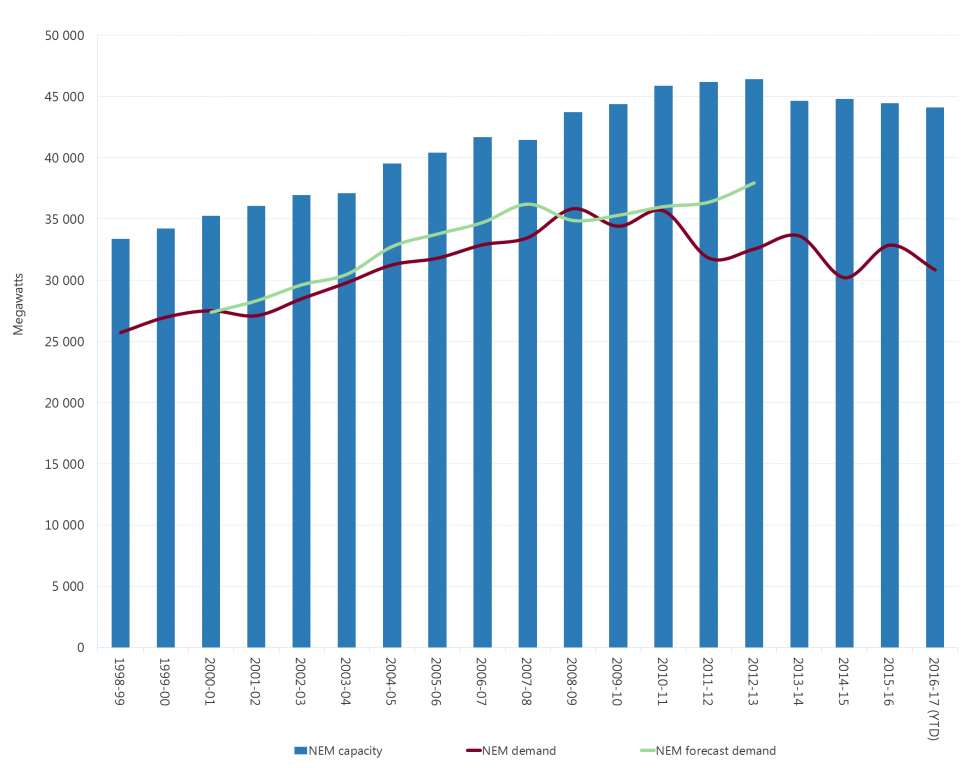
You’ll note that the 1600MW Hazelwood closure would hardly dent the capacity glut. Yes glut. The problem is much of the spare capacity in the system is gas-fired power which is now uneconomic thanks to the great cartel gouge in the gas market.
Angela Macdonald-Smith is more useful at the AFR:
Even those most pessimistic on the impact of the shutdown of the Hazelwood coal power plant didn’t foresee forward prices surging to the $120-plus per megawatt-hour range.
Given the direct follow-through on business power bills, the step-change in prices looks set to reverberate around the economy more broadly. Industry is seriously worried, as evidenced by the last-ditch effort by Australian Industry Group for government to intervene to keep the generator in operation.
But the relatively sudden removal of 1600 megawatts of capacity at Hazelwood is only part of the story. Experts such as Greg Thorpe at energy and water consultancy Oakley Greenwood say the big uncertainty over the future price and availability of gas is also to blame.
But in terms of the loss of base load capacity its removal is a bigger blow, inevitably increasing reliance on intermittent renewables. An analysis from the Melbourne Energy Institute says some 3500 MW of coal-fired capacity has been removed from the market this decade, outweighing the reduction in baseload demand. Even so, several other coal-fired generators are running at relatively modest capacity rates and can take up the slack.
Here’s the chart (the green arrow is the carbon price abolition, red is Curtis Island LNG startups):
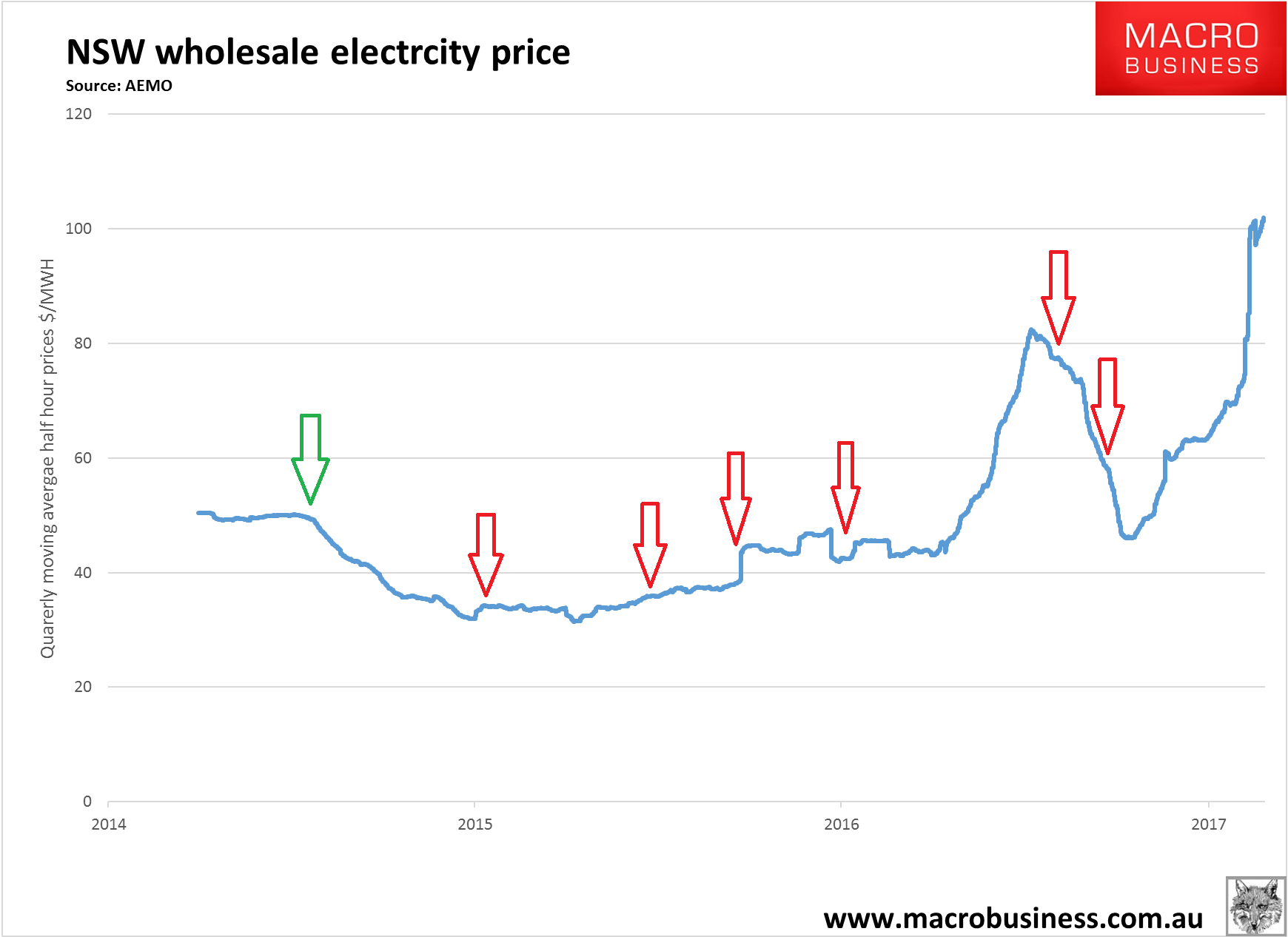
It is gas that sets the marginal cost in the NEM, not coal, owing to where it sits in the wholesale electricity market bid stack. See Australian Energy Market Operator description below:
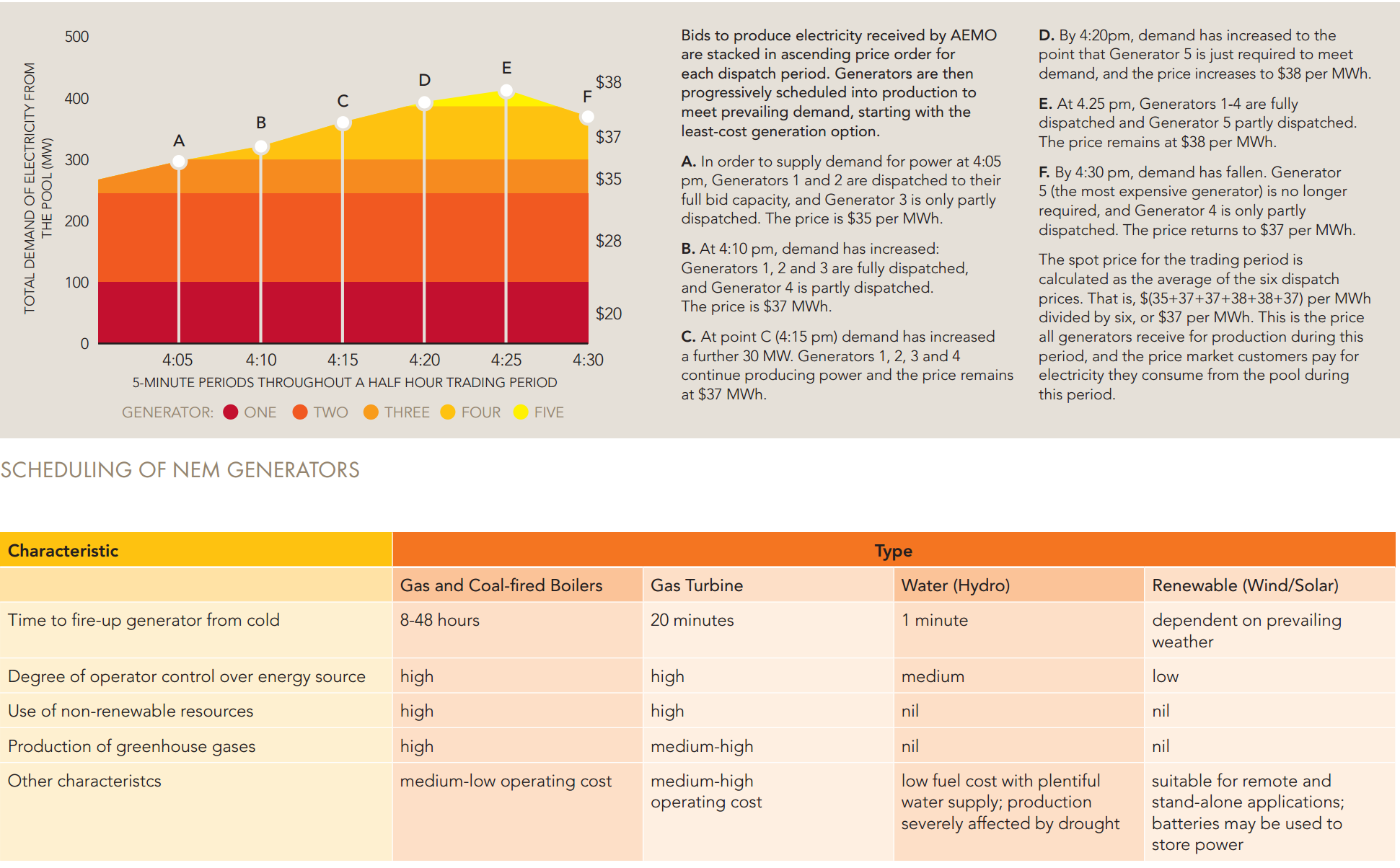
High cost gas sets the marginal price and when the price of gas is high so is the price electricity. This is made worse by the fact that the economics of peaking gas plants (turbines) are far more sensitive to input price changes than are coal-fired power.
We don’t need Hazelwood. We need cheaper gas. Then all of the problems will go away at once and we’ll have time to decarbonise the network with longer term battery and other storage options to stabilise renewables. This was always the national plan, such as it was, that gas would be the transitional fuel as we move steadily from coal power to renewables. The only thing that has gone wrong with it is an east coast gas cartel has formed around Curtis Island and is gouging the shit out of everyone.
So, the real question is, how do we get cheaper gas? More scab grab, via Junket Jen:
Andrew Liveris bluntly calls Australia’s energy policy a “calamity – but not a natural one”.
Instead, the Australian-born chairman and chief executive of Dow Chemical says the paradox of an “existential energy crisis” in an energy-rich nation reflects the cascading effect of human decisions … inaction, inertia and short-sightedness on the part of policymakers in both major parties.
The result, according to Liveris, is that rather than Australia having the competitive advantage of affordable power, it now has a power supply that is both unaffordable and interrupted.
“These cost escalations have been signalled from long ago and now they have arrived,” he told a business lunch in Melbourne yesterday.
That makes it what he calls a profound challenge to Dow as well as other big manufacturers to maintain their operations here.
“There’s no reason to re-invest here and every reason to leave,” he said.
His hope is that the impact of Australia’s” self-defeating” policy will cause a rethink by governments on the basis of the now familiar logic of never letting a good crisis go to waste.
So the powerful and powerfully connected Liveris was off after lunch to meet Victorian Premier Daniel Andrews to tell him there was absolutely no reason for the state government to have banned conventional gas exploration and development in Victoria.
“Á blanket ban is far too broad. It keeps us from benefiting from resources that could be extracted safely and sustainably,” he said.
I like Mr Liveras but this is useless. Victoria does not have any onshore gas reserves. The table:
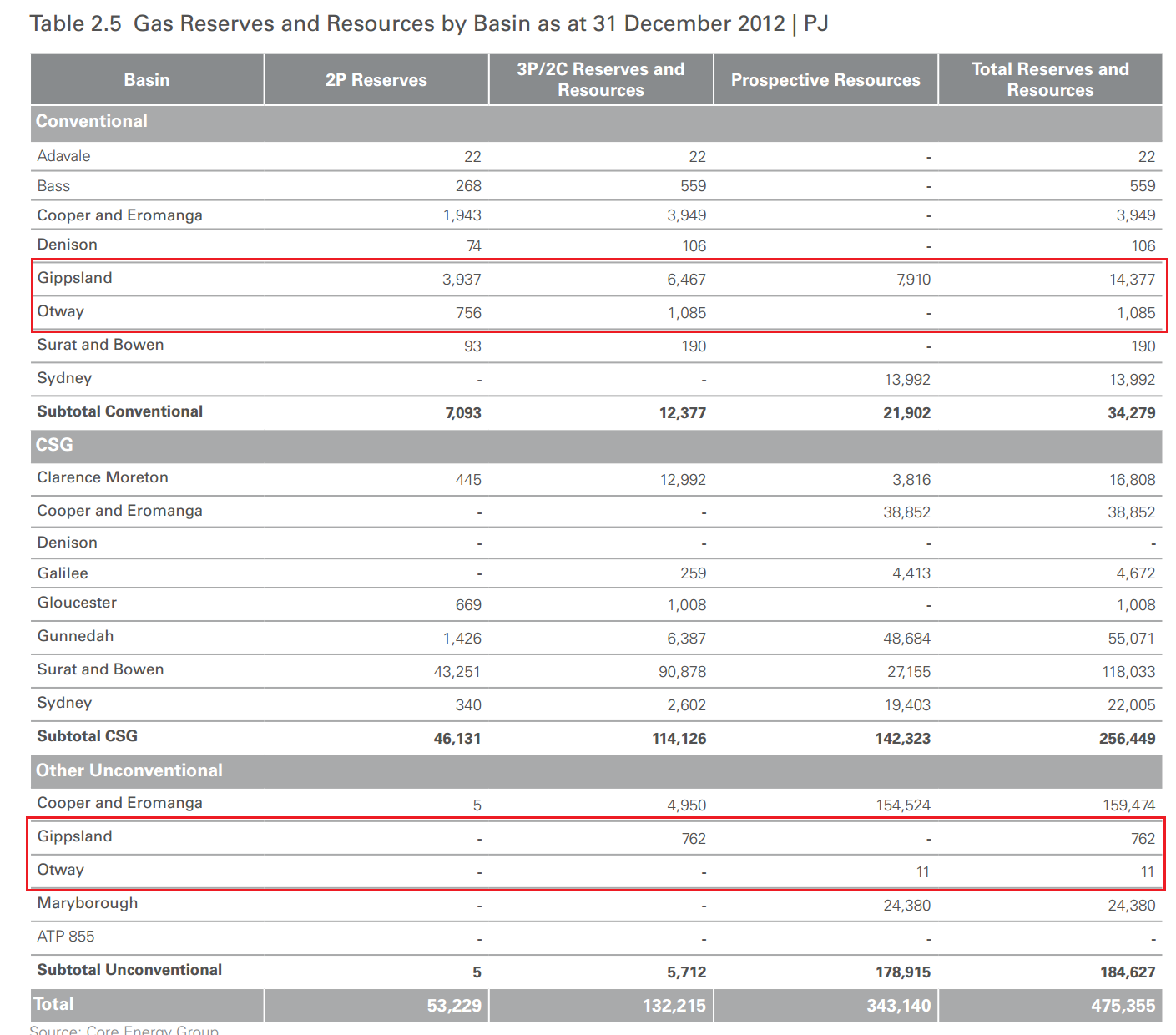
Victorian reserves are all conventional and offshore. Lifting fraccing bans in NSW would help but the community there has reasonable concerns about aquifer pollution.
What we need to fix the energy crisis is as screamingly obvious as it is ignored in the great scab grab. Credit Suisse has made the case:
■ Our preferred option is to reclaim the third-party gas currently being exported: Aside from the Horizon contract between GLNG and Santos, there was no evidence in the EIS or FID presentations that more non-indigenous gas was required. As such, one could argue reclaiming what has only been signed due to a scope failure, is equitable. Including the Horizon contract GLNG will be exporting >160PJa of third-party gas in the later part of this decade. Whilst we get less disclosure these days, BG previously said that after an initial 10–20% in the early days (now gone) QCLNG would use ~5%
■ Our preferred option is to reclaim the third-party gas currently being exported: Aside from the Horizon contract between GLNG and Santos, there was no evidence in the EIS or FID presentations that more non-indigenous gas was required. As such, one could argue reclaiming what has only been signed due to a scope failure, is equitable. Including the Horizon contract GLNG will be exporting >160PJa of third-party gas in the later part of this decade. Whilst we get less disclosure these days, BG previously said that after an initial 10–20% in the early days (now gone) QCLNG would use ~5% thirdparty gas – 20–25PJa. APLNG is self-sufficient, but as can be seen the other thirdparty gas would get extremely close to balancing the market. Clearly these things are far better done by mutual agreement from all parties, rather than a political mandate.
■ GLNG loses but can all be compensated? We estimate that, at a US$65/bbl oil price, GLNG as an entity would lose US$447m p.a. of FCF if they could no longer toll thirdparty volumes. Interestingly, if Kogas and Petronas could recontract their offtake on a slope of 12x (doable in the current LNG market) then their losses as an equity partner are all offset (not equally between the two albeit). Santos would see ~50% of its US$134mn net GLNG loss offset if the Horizon contract could move up to a slope of 8x from 6x. The clear loser would be Total. We wonder whether cheap government debt, a la NAIF, could be provided at the (new, lower volume) project level or even to take/fund an equity stake in it? In reality all parties (domestic buyers included) have some culpability in the situation, so a sharing of pain does not seem unreasonable 02 March 2017 Australia and NZ Market daily 31.
What will it cost us to not fix it?
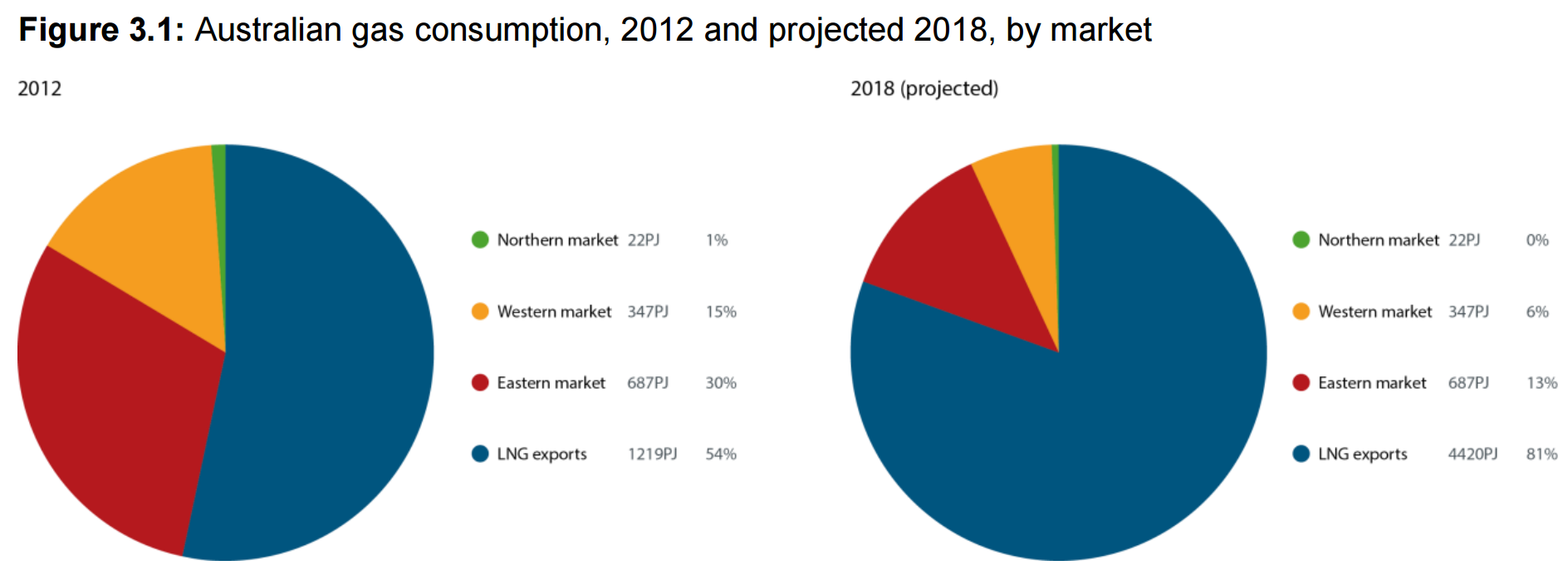
We need to hold back a tiny 160Pj of gas to balance the domestic market. That amounts to a fantastically paltry 2.9% of total national demand or 3.6% of total export volumes in 2018. 80% of Australian gas production would still go to Asia.
At current rates of consumption, east coast gas of 1100PJs will cost $13.2bn at $12GJ. If we held back the 160Pj we could halve that. Electricity prices have also doubled to $100mWh on the gas price and we currently pay out roughly $5bn for our two terrawatts of electricity consumption. So that’s another $2.5bn saving if we can halve it. It is the effective equivalent of a $9bn tax (before we consider the knock-on effects of further capital mis-allocation) levied on east coast households and industry by the foreign shareholders and governments that own Curtis Island LNG. Pure economic rents siphoned off just because they can be.
But that’s not the end of it. These same firms and governments lose money on every tonne that they ship offshore. They buggered up their investment metrics so horribly that when you include the cost of capital for building the plants, they are losing money hand over fist. This even includes the west coast LNG plants. As a result they can claim huge depreciation and write-offs on massively inflated investments and they pay no tax.
Australian LNG blew an enormous bubble that has now burst. It did it all by itself. The fallout is being redirected onto the east coast economy via a cartel gouge that is shuttering manufacturers and artificially turning huge electricity market spare capacity to shortage, jeopardising the energy security of the entire east coast of the country.
The only rightful place for the pain is the LNG projects themselves. Anything else is manifestly insane.

